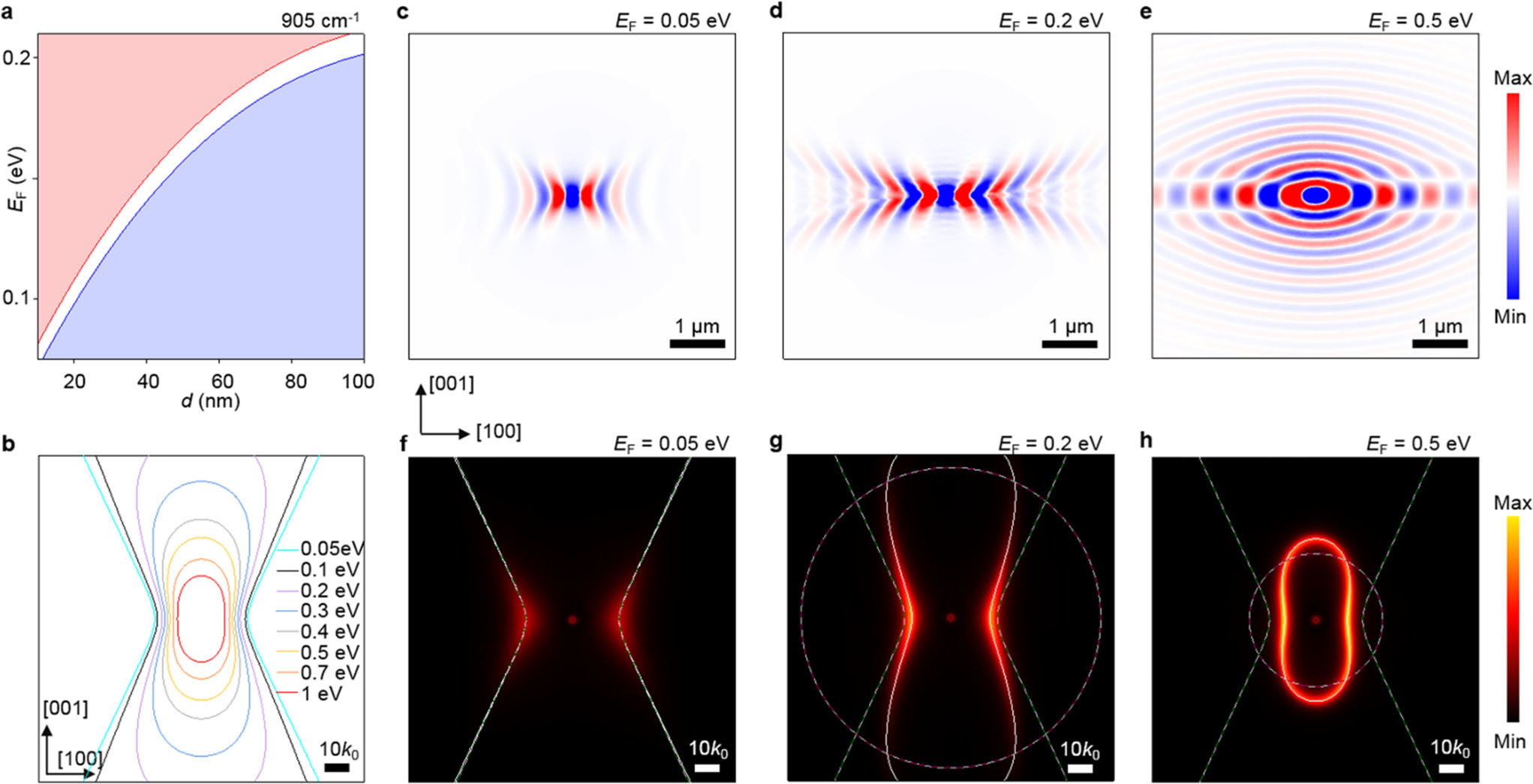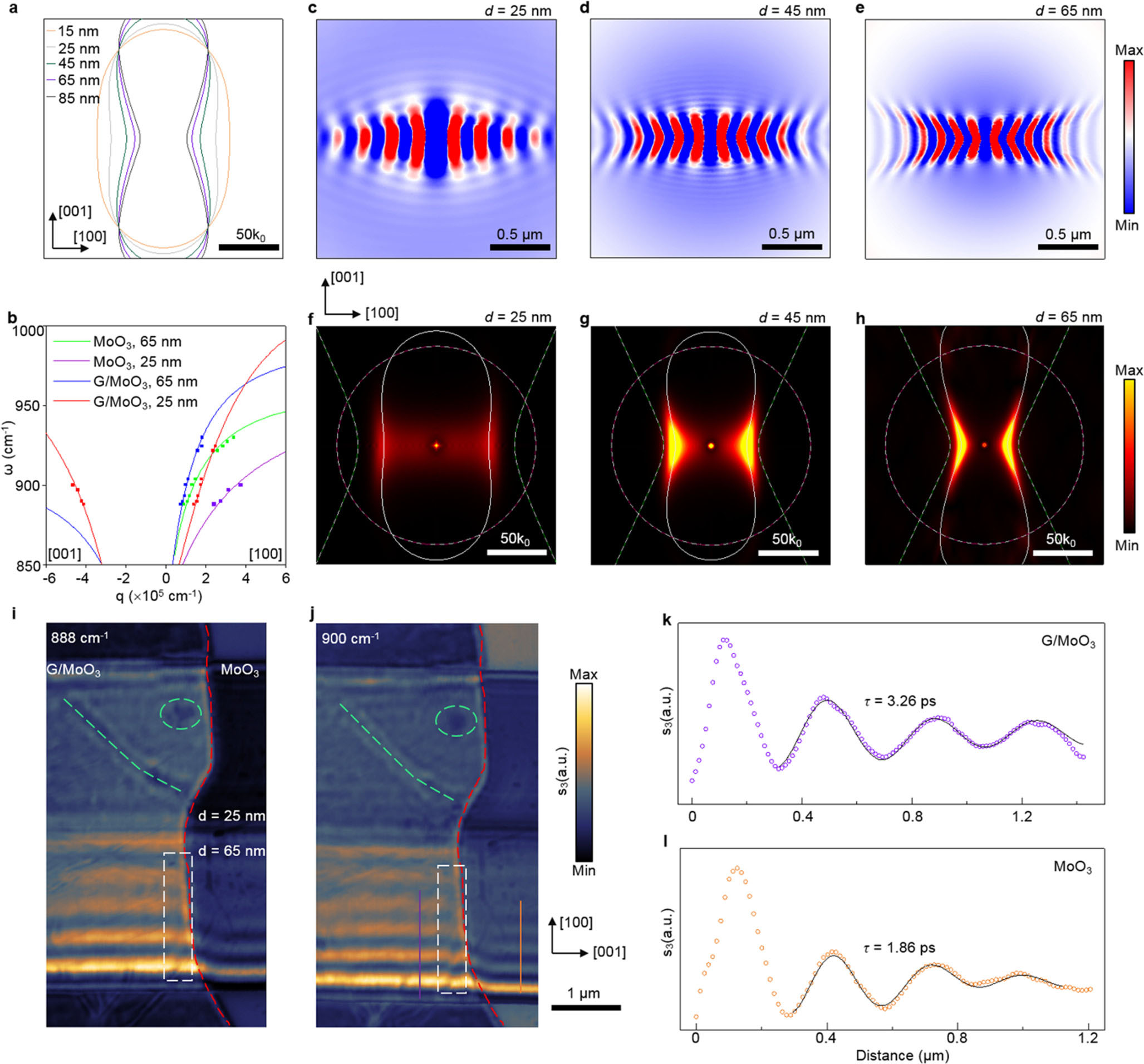| Apr 22, 2022 | |
Interface engineering enables tunable topological transitions in biaxial crystals |
|
| (Nanowerk Spotlight) Polaritons in biaxial crystals offer a promising route to manipulate nanoscale light-matter interactions. The dynamic modulation of their dispersion is of great significance for future integrated nano-optics but remains challenging. Here, we report tunable topological transitions in a graphene and α-MoO3 (G/MoO3) heterostructure. | |
| We theoretically demonstrate and experimentally verify such tailored polaritons at the interface of heterostructures. The interface engineering may shed new light on programmable polaritonics, energy transfer, and neuromorphic photonics (Nano Letters, "Tailoring Topological Transitions of Anisotropic Polaritons by Interface Engineering in Biaxial Crystals"). | |
| Polaritons – hybrid quasi-particles with photons – provide a unique way to harness and manipulate light on the nanoscale due to the strong light-matter interaction. The emergent polaritons in van der Waals materials feature low loss and ultrahigh confinement, promising integrated and ultrathin nanophotonic devices. | |
| This great promise relies on their controllable propagation characteristics as dominated by the dispersion of polaritons. The current main approaches to achieve tailorable polaritons and their topological transition include: structured van der Waals materials (graphene or hBN nanoribbons), heterostructures (α-MoO3/SiC), and twisted bilayer (twisted graphene nanoribbons, twisted α-MoO3 bilayers). | |
| However, all these engineering tool lacks dynamic tunability. The active tuning of anisotropic polaritons and their topological transitions is highly desired for integrated photonic circuits but remains unexplored. | |
| "In this context, we theoretically demonstrate such tailored polaritons at the interface of heterostructures between graphene and α-MoO3," Professor Zhigao Dai from Faculty of Materials Science and Chemistry, China University of Geosciences, tells Nanowerk. "The interlayer coupling can be modulated by both the stack of graphene and α-MoO3, and the magnitude of Fermi level in graphene enabling a dynamic topological transition." | |
 |
|
| Tunable hybrid plasmon-phonon polaritons in graphene/α-MoO3 heterostructures. (a) Relationship between the Fermi level required for a wavefront transition at 905 cm–1 and the thickness of α-MoO3. (b) Isofrequency curves for the hybrid polaritons in the graphene/α-MoO3 heterostructure with different Fermi levels in graphene at 905 cm–1. The heterostructure is stacked on a SiO2/Si substrate. (c–e) Simulated field distributions Re(Ez) and (f–h) the corresponding FFT images of hybrid plasmon–phonon polaritons in graphene/α-MoO3 heterostructures. The white solid curves denote the calculated dispersion bands of heterostructures. The green and red dashed curves correspond to the dispersion curves of graphene with different Fermi levels and α-MoO3 on the substrate, respectively. The thickness of α-MoO3 is 100 nm. (Reprinted with permission by American Chemical Society) | |
| "In this work, we proposed three configurations to fully engineer the interface of graphene/α-MoO3 heterostructures: α-MoO3/graphene heterostructure, graphene/α-MoO3 heterostructure and graphene/α-MoO3/graphene heterostructure,” said Professor Huanyang Chen from the Department of Physics, Xiamen University. "Due to the substrate with broken symmetry in the z-direction, the graphene surface plasmon polaritons with different momentum are excited in three heterostuctures, resulting in different coupled hybrid polaritons. The topological transitions can occur in these three heterostructures." | |
| Furthermore, the hybrid polaritons were experimentally verified in the G/MoO3 heterostructure. The wavelengths and wavevectors of hybrid polaritons can also be easily tuned along different directions over a wide spectral range by just slightly changing the excitation frequency. | |
| As a van der Waals material, the thickness of α-MoO3 is an important factor for tuning the dispersion of hyperbolic polaritons, which will thus affect the hybrid plasmon-phonon polaritons in G/MoO3 heterostructures. | |
| More interestingly, an open-to-closed wavefront transition occurs at a constant Fermi level when tuning the thickness of α-MoO3. | |
 |
|
| Thickness-dependent hybrid plasmon-phonon polaritons in graphene/α-MoO3 heterostructures. (a) Isofrequency curves for the hybrid polaritons in the graphene/α-MoO3 heterostructure with different thicknesses of α-MoO3 at a frequency of 905 cm–1. The heterostructure is stacked on a SiO2/Si substrate. (b) Dispersion relations for PhPs and hybrid polaritons in different structures. The solid curves represent the analytical results, and the dots indicate experimental data extracted from s-SNOM. The Fermi level of graphene is 0.2 eV. (c–e) Simulated field distributions Re(Ez) and (f–h) the corresponding FFT images for the graphene/α-MoO3 heterostructure. The white solid curves denote the calculated dispersion bands of heterostructures. The green and red dashed curves correspond to the dispersion curves of the graphene and α-MoO3 with different thicknesses on the substrate, respectively. Experimentally measured field distributions at (i) 888 cm–1 and (j) 900 cm–1. The Fermi level of graphene is 0.2 eV. Line plots of measured hybrid polaritons along the (k) purple line and (l) orange line in (j). The dots are the measured data, and the solid curves are the fittings. (Reprinted with permission by American Chemical Society) (click on image to enlarge) | |
| To corroborate the theoretical results, a G/MoO3 heterostructure with different thickness of α-MoO3 was fabricated, verifying the elliptical dispersion of hybrid polaritons. Due to the abrupt thickness change in α-MoO3, the thick part of G/MoO3 with limited width can be approximately considered as a cavity due to the reflection by the step. | |
| The polaritons in the thicker part of G/MoO3 heterostructure are then likely to form resonance, resulting in an improved lifetime of hybrid plasmon-phonon systems. | |
| The tailored polaritons and the tunable topological transitions of hybrid polaritons may lay a foundation for the construction of electronically tunable polaritonic devices, optical signal processing, or neuromorphic photonic circuits based on low-loss polaritons. | |
| Provided by Yali Zeng and Prof. Huanyang Chen, both Department of Physics, Xiamen University; and Prof. Zhigao Dai, Faculty of Materials Science and Chemistry, China University of Geosciences | |
|
Become a Spotlight guest author! Join our large and growing group of guest contributors. Have you just published a scientific paper or have other exciting developments to share with the nanotechnology community? Here is how to publish on nanowerk.com. |
|
